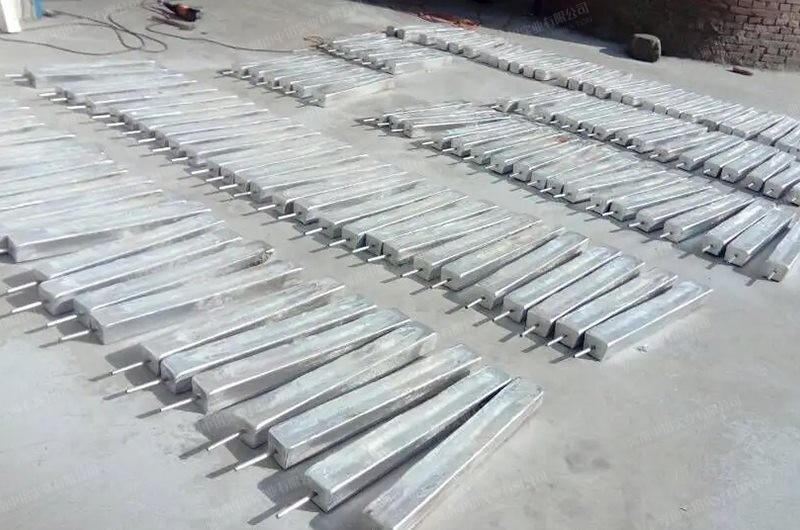
- Aluminum alloy sacrificial anode
- Magnesium alloy sacrificial anode
- Impressed current cathodic protection series
- Zinc alloy sacrificial anode
Application of aluminum anode in submarine pipeline
The cathodic protection of submarine pipelines can use forced current method and sacrificial anode method. The principles of the two methods are the same, both of which make the submarine pipeline cathodic polarization to a certain extent, which has achieved the purpose of protection. Since the sacrificial anode protection method is mature in technology, reliable in performance, does not require external power supply, is simple and easy to implement, does not require special personnel to manage, does not interfere with other facilities, and has low cost, currently, the sacrificial anode protection method is used for submarine pipelines.

The sacrificial anode method is to connect the protected metal (cathode) with an alloy (anode) with a more negative potential than it, and use the potential difference between the two to form a corrosion battery. Protect.
The aluminum anode has a driving voltage of about 0.3V for iron. This driving voltage is more suitable, about 0.3V, with high current efficiency and large theoretical capacitance. There are fewer speculations about using aluminum anodes. However, pure aluminum should not be directly used as a sacrificial anode material. Pure aluminum has more active chemical properties, and the surface is easily passivated to form a dense oxide film. Adding other metals to aluminum can greatly improve the current efficiency. The aluminum anode itself is suitable for the environment of seawater, and the chloride in the seawater can activate the oxide film generated on the surface of the aluminum. Therefore, aluminum anodes are mostly used for cathodic protection of submarine pipelines.
Advantages and applications of aluminum anodes
- Aluminum alloy sacrificial anode has extremely high electrochemical performance. About 2900Ah/kg. The theoretical electricity generated by the zinc anode is 820Ah/kg. The theoretical electricity generated by the magnesium anode is 2210Ah/kg. The larger the capacitance, the less amount of sacrificial anode is required.
- Compared with steel, the aluminum alloy sacrificial anode has a more suitable driving voltage, which is about 300mv. The driving voltage of the zinc anode is 220mv, and the driving voltage is low, so it can only be used in the environment with low electrolyte resistivity. The standard electrode potential of magnesium alloy is -2.73V (relative to the standard hydrogen electrode), and the driving voltage is high, which is easy to cause overheating. Protect. Zinc anode standard potential -0.762v (vs HSE) magnesium anode standard potential -2.37v, aluminum anode standard potential -1.66v.
- Higher current efficiency.
- The specific gravity of aluminum is smaller, which is much smaller than that of magnesium sacrificial anodes, and the weight per unit volume of aluminum anodes is smaller, which is easy to manufacture and install.
- Aluminium is one of the highest elements in nature, with less investment.
- Aluminum is easy to form an oxide film on the surface of air or water. The oxide film has a high resistivity and is insoluble in water, which affects the current output of the aluminum anode. The environment of seawater is suitable for aluminum anodes. Seawater contains more sodium chloride, and chloride ions are An active cation that can easily attach to the passivation film on the surface of the aluminum anode, combine with the cations on the passivation film, push out oxygen atoms, and generate water-soluble chloride.
- The sacrificial anode also has the function of automatically adjusting the current and potential. The influence of the medium composition on the performance of the sacrificial anode. The pH value of natural seawater is often stable between 7.9 and 8.4. The zinc anode produces zinc hydroxide, which is insoluble in water, resulting in the failure of the surface passivation of the zinc anode. The efficiency of magnesium anodes will decrease in seawater, and magnesium alloys are not suitable for low-resistivity media such as seawater.

Free offer of products, welcome to consult at any time, we will give the first reply.Our Email:
